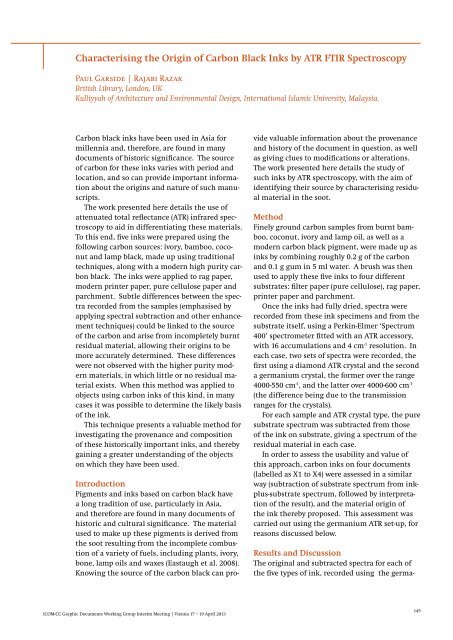Paper Conservation: Decisions & Compromises
Paper Conservation: Decisions & Compromises
Paper Conservation: Decisions & Compromises
Create successful ePaper yourself
Turn your PDF publications into a flip-book with our unique Google optimized e-Paper software.
Characterising the Origin of Carbon Black Inks by ATR FTIR Spectroscopy<br />
Paul Garside | Rajabi Razak<br />
British Library, London, UK<br />
Kulliyyah of Architecture and Environmental Design, International Islamic University, Malaysia.<br />
Carbon black inks have been used in Asia for<br />
millennia and, therefore, are found in many<br />
documents of historic significance. The source<br />
of carbon for these inks varies with period and<br />
location, and so can provide important information<br />
about the origins and nature of such manuscripts.<br />
The work presented here details the use of<br />
attenuated total reflectance (ATR) infrared spectroscopy<br />
to aid in differentiating these materials.<br />
To this end, five inks were prepared using the<br />
following carbon sources: ivory, bamboo, coconut<br />
and lamp black, made up using traditional<br />
techniques, along with a modern high purity carbon<br />
black. The inks were applied to rag paper,<br />
modern printer paper, pure cellulose paper and<br />
parchment. Subtle differences between the spectra<br />
recorded from the samples (emphasised by<br />
applying spectral subtraction and other enhancement<br />
techniques) could be linked to the source<br />
of the carbon and arise from incompletely burnt<br />
residual material, allowing their origins to be<br />
more accurately determined. These differences<br />
were not observed with the higher purity modern<br />
materials, in which little or no residual material<br />
exists. When this method was applied to<br />
objects using carbon inks of this kind, in many<br />
cases it was possible to determine the likely basis<br />
of the ink.<br />
This technique presents a valuable method for<br />
investigating the provenance and composition<br />
of these historically important inks, and thereby<br />
gaining a greater understanding of the objects<br />
on which they have been used.<br />
Introduction<br />
Pigments and inks based on carbon black have<br />
a long tradition of use, particularly in Asia,<br />
and therefore are found in many documents of<br />
historic and cultural significance. The material<br />
used to make up these pigments is derived from<br />
the soot resulting from the incomplete combustion<br />
of a variety of fuels, including plants, ivory,<br />
bone, lamp oils and waxes (Eastaugh et al. 2008).<br />
Knowing the source of the carbon black can provide<br />
valuable information about the provenance<br />
and history of the document in question, as well<br />
as giving clues to modifications or alterations.<br />
The work presented here details the study of<br />
such inks by ATR spectroscopy, with the aim of<br />
identifying their source by characterising residual<br />
material in the soot.<br />
Method<br />
Finely ground carbon samples from burnt bamboo,<br />
coconut, ivory and lamp oil, as well as a<br />
modern carbon black pigment, were made up as<br />
inks by combining roughly 0.2 g of the carbon<br />
and 0.1 g gum in 5 ml water. A brush was then<br />
used to apply these five inks to four different<br />
substrates: filter paper (pure cellulose), rag paper,<br />
printer paper and parchment.<br />
Once the inks had fully dried, spectra were<br />
recorded from these ink specimens and from the<br />
substrate itself, using a Perkin-Elmer ‘Spectrum<br />
400’ spectrometer fitted with an ATR accessory,<br />
with 16 accumulations and 4 cm -1 resolution. In<br />
each case, two sets of spectra were recorded, the<br />
first using a diamond ATR crystal and the second<br />
a germanium crystal, the former over the range<br />
4000-550 cm -1 , and the latter over 4000-600 cm -1<br />
(the difference being due to the transmission<br />
ranges for the crystals).<br />
For each sample and ATR crystal type, the pure<br />
substrate spectrum was subtracted from those<br />
of the ink on substrate, giving a spectrum of the<br />
residual material in each case.<br />
In order to assess the usability and value of<br />
this approach, carbon inks on four documents<br />
(labelled as X1 to X4) were assessed in a similar<br />
way (subtraction of substrate spectrum from inkplus-substrate<br />
spectrum, followed by interpretation<br />
of the result), and the material origin of<br />
the ink thereby proposed. This assessment was<br />
carried out using the germanium ATR set-up, for<br />
reasons discussed below.<br />
Results and Discussion<br />
The original and subtracted spectra for each of<br />
the five types of ink, recorded using the germa-<br />
ICOM-CC Graphic Documents Working Group Interim Meeting | Vienna 17 – 19 April 2013<br />
145
















